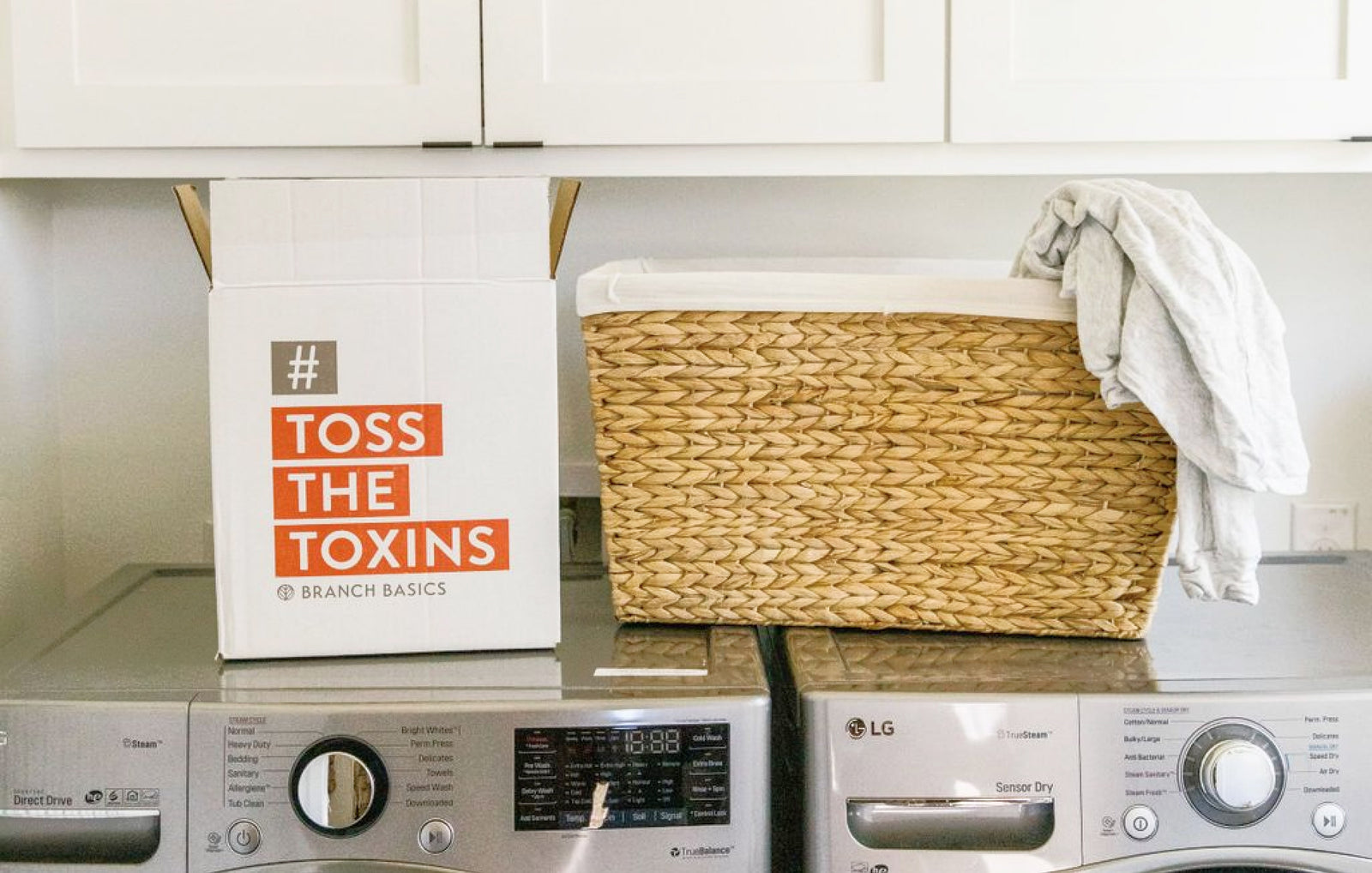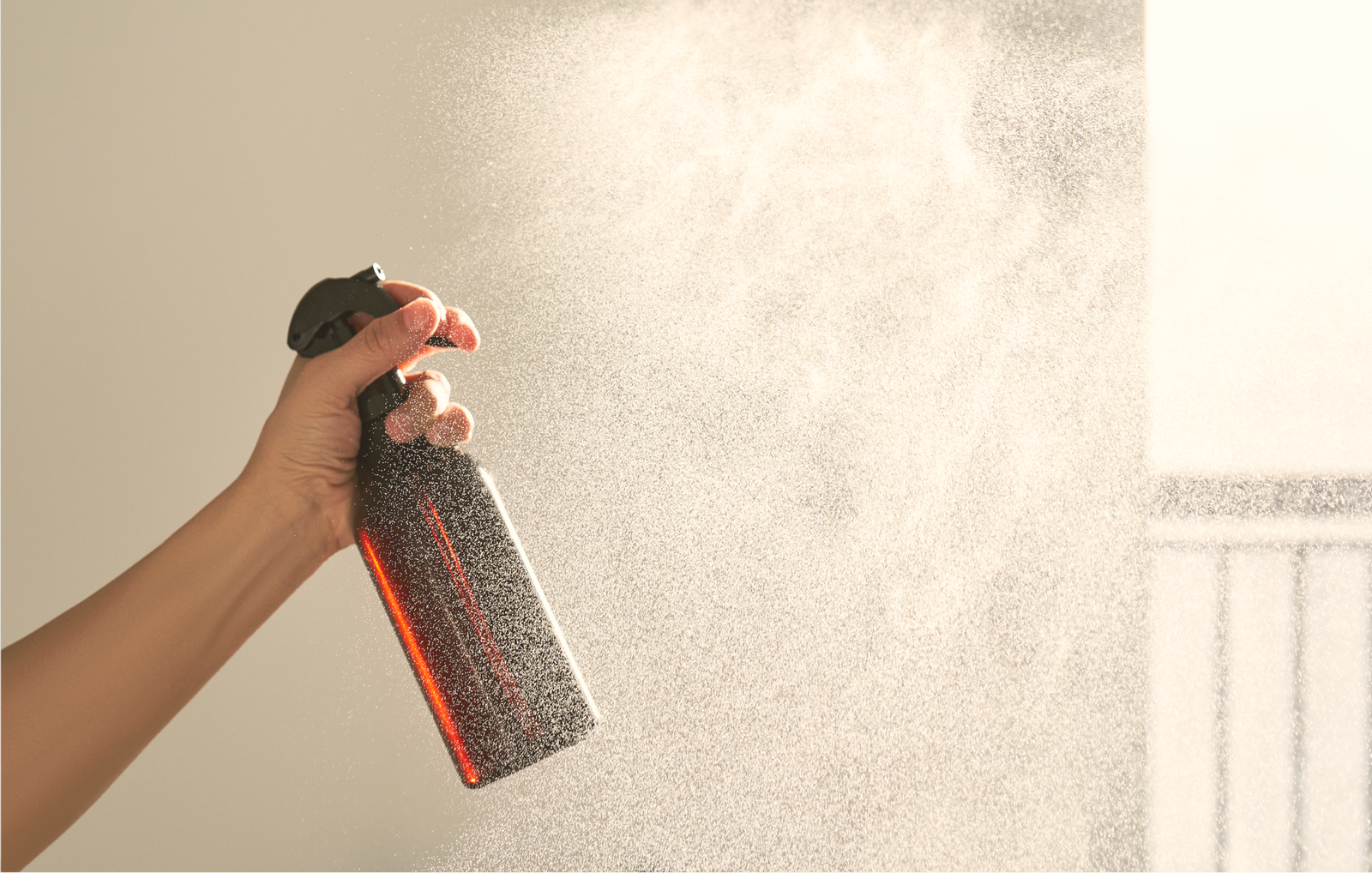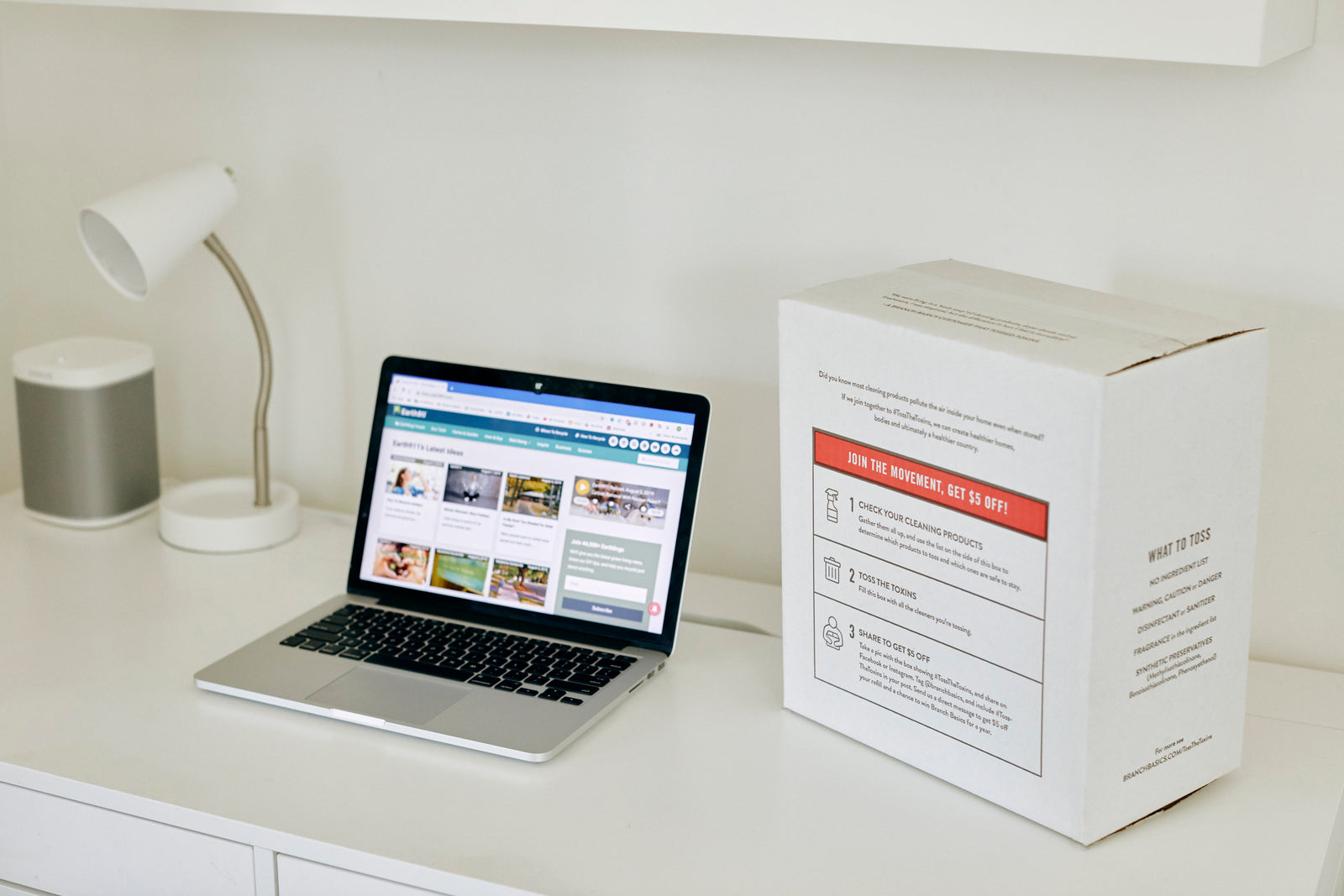How to Toss Your Toxic Laundry Detergent

Have you ever walked around your neighborhood and noticed that fresh smell of someone doing laundry?
Bad news: when you breathe in that “clean” familiar scent, you’re actually getting a lung-full of toxic synthetic chemicals.
Is laundry detergent toxic?
When scented laundry detergents and fabric softeners are used, dryer vents emit more than 25 volatile organic compounds (VOCs) per load, many of which are classified as hazardous air pollutants.
If the dryer vent is blocked or if it doesn’t vent to the outside, then the indoor air pollution skyrockets when the dryer is in use.
If the vent is not blocked to the outdoors, then the air in your neighborhood ends up getting polluted with VOCs.
So, the truth is those synthetic laundry chemicals you use can impact the air quality in your home, your health, and even the outdoor air around your house.
It's only a small amount of detergent, right?
Since the average family in the United States washes about 80 pounds of laundry each week, with ½ cup of detergent per load, an average of 4 cups of detergent per home ends up in the waterways and affecting air quality each week.
Each piece of laundry you pull out of the washing machine contains synthetic residues from detergents, which not only lingers in the fabric, but rubs off on your skin.
Conventional detergents are comprised of a concoction of synthetic fragrances, endocrine disruptors, neurotoxins and potent synthetic chemicals.
Most detergents have signature fragrances which are designed to impregnate and stay in clothes. The unscented versions add synthetic masking chemicals, which simply cover up the fragrance with another chemical.
Your laundry room may very well be the most toxic room in your home once these synthetic chemicals become airborne when washing and drying your clothes.
See Detoxifying Your Laundry Room to dig in more after reading this article!
This is a major problem in light of the fact that scientists are directly linking the alarming rise of degenerative disease in America to exposure to chemicals in our homes and workplaces.
Consider that the American Cancer Society states that today, one in three men and one in two women will have cancer in their lifetime.
After accidents, cancer is now the second leading cause of death in children and exposure to synthetic chemicals in our homes is a leading factor.
Taking a look at the products we use is a first step to start reducing our exposures to these synthetic chemicals.
All laundry detergent ingredients can potentially be absorbed through the skin or breathed in through the nose, as well as passed down the drain to damage aquatic life and our waterways.
Since government agencies do not regulate synthetic chemicals in cleaning products, it is time to open our eyes to toxic blind spots and start making healthier choices.
We have the power to remove products with harmful ingredients from our homes. So take charge, protect your family and make a commitment to only bring in health-promoting products.
Synthetic chemicals: why did they end up in our laundry products?
A brief history of laundry detergent
Prior to World War I, people around the world used pure soap to do their laundry.
In 1916, driven by the war related shortage of fats and oils, Germany developed the first synthetic detergent to be used for laundry and dishwashing.
In the United States, efforts to create detergents for household use by companies like Procter and Gamble started in the early 1930s.
Detergents did not start to displace soap in the US until the end of World War II when, like Germany in World War I, the fats and oils used in soap making were in short supply.
These fats and oils were more useful for manufacturing explosives for the war effort.
Scientists at that time discovered that they could make thousands of petrochemicals (synthetic chemicals derived from petroleum) that could be used to replace natural ingredients.
After the war, many factories were converted for civilian use and a petroleum-based chemical, tetra propylene, was used in the creation of laundry detergents.
By the 1950s, detergents almost completely replaced soap as the first choice in America for doing laundry.
Most detergents available today are loaded with synthetic petrochemicals and are undermining our health.
Reading labels doesn’t have to be complicated
Look for the words “caution”, “warning”, or “danger” on the box or bottle.
Those words (especially "warning" and "danger") are a giveaway that there are potentially toxic synthetic chemicals in the product.
It's best to simply remove the product from your home.
Also, look out for common precautionary statements like “Eye, Skin, or Lung Irritant”.
For the most part, these precautionary labels signal the presence of synthetic chemicals. If in doubt, get 'em out!
Dig deeper to be in the know
We’ve pulled together a glossary of the toxic red flags that are commonly found in laundry detergents and fabric softeners - see The Toxic Chemicals Hidden In Dryer Sheets & Fabric Softener.
Not only are these synthetic chemicals potentially damaging to your health, they are also contaminating waterways and harming the environment.
Also remember the single word “fragrance” can include one of over a thousand different ingredients.
Related Reading: Ditch the Fabric Softener: 7 Natural Alternatives

A few synthetic laundry chemicals you should know

- Synthetic fragrances - Fragrance is mentioned first because hundreds of synthetic chemicals are hidden in "trade secret" fragrance recipes that do not have to be disclosed or tested. According to the Environmental Working Group (EWG) fragrances are considered to be among the top five allergens and can trigger asthma attacks. Testing by EWG also revealed that 75% of the fragrances contain phthalates (pronounced “thal-ates”). Phthalates have been linked to diabetes, obesity and hormone disruption which affects both development and fertility. Mt. Sinai Children's Environmental Health Center has linked exposure to synthetic fragrance in first and third trimester prenatal exposure to ADHD and autism.
- Natural fragrances - “Natural” fragrance doesn’t necessarily mean safe. In a study analyzing 25 top selling products, those with so-called “organic” and “natural” fragrance emitted just as many hazardous chemicals as conventional products with fragrance. Most natural fragrance/essential oils in detergents are processed with solvents because it is less expensive than distillation. The VOCs from the solvents were present in every product tested in this study. In addition, limonene and other terpenes such as pine and citrus oils (found in essential oils) react with ozone in the surrounding air to create secondary pollutants such as formaldehyde, acetaldehyde, acetone, and ultra-fine particles. This can particularly be an issue on high ozone alert days.
- Unscented detergents – Be aware that unscented versions of products are typically the same as the synthetic fragranced version; these don’t have a scent, thanks to the addition of a synthetic masking chemical.

- Optical brighteners – Most laundry detergents contain optical brighteners, which are formulated to intentionally remain in the clothes. They leave a synthetic residue on the clothes that reflect light and make clothes look brighter, with more vivid colors. These synthetic chemicals are constantly in contact with the skin and are breathed in through the lungs. Optical brighteners have the capacity to make skin become photo-reactive and more sensitive to sun exposure. Many people develop skin irritation and rashes from exposure to optical brighteners. Not to mention that they are toxic to fish and cause bacterial mutations!
- Nonylphenol Ethoxylates (NPEs) – This group of inexpensive, nonionic surfactant petrochemicals has already been banned in Canada and the European Union, but it still found in American detergents. NPEs are endocrine disruptors that adversely affect physical function and fetal development. Infants and children are especially vulnerable to these synthetic chemicals, which are known to adversely affect neurologic, immune, cardiac, kidney, and liver function as well. NPEs are frequently considered to be biodegradable, but the truth is, they slowly biodegrade into even more toxic compounds, profoundly interfering with the hormones of fish and shellfish. Even Wal-Mart has listed NPEs as one of three synthetic chemicals they're asking suppliers to phase out.
- Bleach, aka sodium hypochlorite – Bleach is involved in more household poisonings than any other synthetic chemical. Sodium hypochlorite and other synthetic cleaning chemicals such as synthetic fragrances and surfactants react to generate chlorinated VOCs, which are very toxic and are considered human carcinogens. Chlorinated compounds are emitted during use; as it flows down the drain, bleach can produce organochlorines (OC), which are endocrine disruptors, neurotoxic, and carcinogenic. Bleach is not only harmful to health but also degrades both synthetic and natural fibers, reducing their longevity.

- Linear Alkyl Benzene Sulfonates (LAS) - These synthetic petrochemicals are normally listed as 'anionic surfactants' on labels, and are one of the most common surfactants in use. During their production process, carcinogenic and reproductive toxins such as benzene are released into the environment. They also biodegrade slowly, making them a hazard in the environment. The amount of LAS used in detergents may vary to as high as 30% of the weight of the total product!
- Phosphates - Phosphates are the main cleaning ingredient in many detergents and household cleaners because they break down dirt particles and remove stains by softening the water and allowing suds to form, which enhances the cleaning power of the detergent. However, there are human health problems as well as major environmental hazards associated with phosphates. Phosphate residues on items that have been cleaned with phosphate-containing detergents have been known to cause nausea, diarrhea, and skin irritation. Phosphates are persistent, too. They remain active even after wastewater treatment processes and end up in rivers and lakes, where they act as a “toxic fertilizer”. In the water system, they increase algae growth and suffocate salmon and other aquatic life, literally starving them of oxygen. As the algae die, they release poisons that further deplete the waterways of oxygen.
- Sodium Lauryl Sulfate (SLS), Sodium Laureth Sulfate (SLES), and Ammonium Laurel Sulfate (ALS) are commonly used in many detergents and act as surfactants and emulsifiers, giving the detergent foaming abilities. Over 16,000 research studies on SLS have shown links to irritation of the skin and eyes, organ toxicity, developmental/reproductive toxicity, neurotoxicity, endocrine disruption, ecotoxicology, and biochemical or cellular changes, and even cancer.
-
1,4-Dioxane, also called Dioxane or Diethylene Oxide – Dioxane is a byproduct of ethoxylation, an inexpensive shortcut process companies use to produce softer, sudsier detergents. It’s not even added intentionally, but it is an extremely common ingredient in detergents, appearing in about 2/3 of laundry products studied. Since it is a byproduct rather than ingredient, it doesn't have to be listed on product labels. Yet it is considered by the State of California to cause cancer and can be toxic to your brain and central nervous system, kidneys, liver and respiratory system. The U.S. federal regulation systems consider dioxane's potency to be equivalent to or greater than many pesticides considered dangerous to humans. Detergents contaminated with 1,4-dioxane may also have traces of other contaminants, including formaldehyde, nitrosamines, and phthalates. The National Institute of Health (NIH) considers even trace amounts to be cause for concern and the EPA has classified dioxane as a Class B possible carcinogen. When you use a laundry detergent contaminated with dioxane, it goes everywhere. It never breaks down. Water filters can't remove it—and it isn't biodegradable. To avoid 1,4 dioxane, the Organic Consumers Association (OCA) recommends avoiding products with indications of ethoxylation. Look for the following suffixes in the ingredient list:
- Myreth, oleth, laureth, ceteareth, and any other "eth"
- PEG
- Polyethylene, polyethylene glycol, or polyoxyethylene
- Oxynol
- Sodium laureth/laurel sulfate
- Petroleum distillates (aka napthas): These are solvents used to dissolve dirt, grease and grime that have been linked to mucus membrane damage, lung damage and inflammation, asthma, and cancer. They are derived from synthetic crude oil.
- Phenols: Phenol is recognized as being so toxic that people who are hypersensitive to it could experience death or serious side effects at very low exposures. It is rapidly absorbed and can cause toxicity throughout the entire body, wreaking havoc on the the central nervous system, heart, blood vessels, lungs and kidneys.
What to do?
Don’t let this “laundry list” of synthetic chemicals leave you feeling overwhelmed and concerned for your health and the health of your family.
There are easy steps you can take to immediately improve your air quality.
We recommend starting with three simple changes to protect your family’s health and the environment.
Wondering where to start? Check out these tips for implementing a clean lifestyle.
Related Reading: 7 Human-Safe and Environmentally Safe Laundry Bleach Alternatives
It's Easy to Choose Safe Products
You don't need to be a chemist or scientist to determine what is and what is not safe!
Just google EWG Skindeep and each ingredient on a product.
Ingredients are rated from 1-10. We recommend tossing any product with an ingredient rated 3 or above.
At Branch Basics, we have two safe and effective laundry products.
Our Laundry Detergent powder is incredibly convenient and simple to use, requiring just one scoop per load with no additional products needed. It also performs well in cold water, saving energy and preserving fabric integrity.
Learn more about our Laundry Detergent here.
Secondly, our Concentrate Laundry Solution uses our liquid Concentrate model, where you mix water with the Concentrate in a Laundry Solution bottle and add a scoop of our Oxygen Boost for extra cleaning power. We do recommend this product for the extremely chemically sensitive and chemically injured.
Choose the option that best fits your laundry routine and needs!
Further reading:
Here’s how to use Branch Basics for Laundry (instead of conventional detergents) and how to ditch your dryer sheets.
To learn our best tricks for stain removing, check out our Stainmaster Guide. You’ll be a stainmaster in no time!
Categories

Marilee Nelson
Marilee Nelson is an Environmental Toxins expert who has spent nearly 30 years advocating for the chemically-sensitive and chronically-ill. She is a Board Certified Nutritionist, Certified Bau-Biologist and Bau-Biology Inspector and specializes in Food As Medicine. She has helped thousands of families and individuals identify, heal and recover from toxic exposures and is on a mission to revolutionize the way American families view their health.








